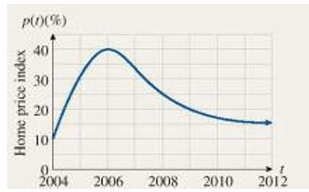HOW TO FIND AT WHICH POINT HORIZONTAL TANGENT CAN BE DRAWN
Problem 1 :
For what values of x does the graph of f(x) = (x2 + 1) (x + 3) have horizontal tangent ?
Solution :
f(x) = (x2 + 1) (x + 3)
From the given function, find the firs derivative to get the slope.
Since the functions are multiplied, we have to product rule to find the derivative.
Product rule :
d(uv) = uv' + vu'
u = (x2 + 1) and v = x + 3
u' = 2x and v' = 1
f'(t) = (x2 + 1) (1) + (x + 3) (2x)
= x2 + 1 + 2x2 + 6x
= 3x2 + 6x + 1
Put f'(t) = 0
3x2 + 6x + 1 = 0
Since this quadratic equation is not factorable, will use quadratic formula to solve it.
a = 3, b = 6 and c = 1
x = (-b ± √b2 - 4ac)/2a
= (-6 ± √62 - 4(3)(1))/2(3)
= [-6 ± √(36 - 12)]/6
= [-6 ± √24]/6
= [-6 ± 2√6]/6
x = [-3 ± √6]/3
Hence the curve will have horizontal tangents at
x = [-3 + √6]/3 and x = [-3 - √6]/3
Problem 2 :
Show that the tangents to the curve y = 7x3 + 11 at the points where x = 2 and x = – 2 are parallel.
Solution :
To find the tangent at the given points, we have to find the first derivative and apply the given x-coordinate. If we get the same results in both cases, we say that the tangents drawn at the points are parallel. Because parallel lines will have same slopes.
y = 7x3 + 11
dy/dx = 7(3x2) + 0
= 21x2
|
Slope at x = 2 dy/dx at x = 2 = 21(2)2 = 21(4) = 84 |
Slope at x = -2 dy/dx at x = -2 = 21(-2)2 = 21(4) = 84 |
Since slopes are equal at x = -2 and x = 2, the tangents drawn at these points are parallel.
Problem 3 :
Find the points on the curve y = x3 at which the slope of the tangent is equal to the y-coordinate of the point.
Solution :
Let x -coordinate of the required point be p.
y-coordinate = y = p3
Slope of the tangent dy/dx = 3x2
Slope at x = p, dy/dx = 3p2
Given that, slope of the tangent = y-coordinate of the point
3p2 = p3
p3 - 3p2 = 0
p2(p - 3) = 0
p = 0 and p = 3, then p = 3
If x = 0, y = 0
If x = 3, y = 33 ==> 27
So, the required points are (0, 0) and (3, 27).
Problem 4 :
The home price index as percentage change from 2003 in year t, is represented by y = p(t)

a) What year p'(t) = 0 ?
b) Is p'(2008) positive, negative or zero ?
c) Find the average rate of change from 2006 to 2008.
Solution :
a) By observing the graph given above, we can draw the horizontal tangent line at t = 2006.
b) Observing the graph, after 2006 we see the curve is decreasing. It has negative slope. Then p'(2008) is negative.
c) At t = 2006, y = 40
At t = 2008, y = 25
Average rate of change = (25 - 40) / (2008 - 2006)
= -15/2
= -7.5
7.5% decreasing.
Problem 5 :
The position, in meters, of a body at time 𝑡 0 measured in seconds is
𝑠(𝑡) = t3 - 6t2 - 36t
Find the body’s acceleration each time the velocity is zero.
Solution :
Given that, 𝑠(𝑡) = t3 - 6t2 - 36t
s'(t) = 3t2 - 6(2t) - 36(1)
s'(t) = 3t2 - 12t - 36
When velocity is 0, then s'(t) = 0
3t2 - 12t - 36 = 0
t2 - 4t - 12 = 0
(t - 6)(t + 2) = 0
t = 6 and t = -2
To find the acceleration, we have to find the second derivative.
s''(t) = 3(2t) - 12(1)
= 6t - 12
|
When t = -2 a(t) = 6(-2) - 12 = -12 - 12 a(-2) = -24 |
When t = 6 a(t) = 6(6) - 12 = 36 - 12 a(6) = 24 |
Problem 5 :
Find the points on the curve
y = 2x3 + 3x2 - 12x + 1
where the tangent is horizontal.
Solution :
y = 2x3 + 3x2 - 12x + 1
dy/dx = 2(3x2) + 3(2x) - 12(1) + 0
= 6x2 + 6x - 12
When we draw the horizontal tangent
dy/dx = 0
6x2 + 6x - 12 = 0
x2 + x - 2 = 0
(x - 1)(x + 2) = 0
x = 1 and x = -2
|
When x = 1 y = 2x3 + 3x2 - 12x + 1 y = 2(1)3+3(1)2-12(1)+1 = 2 + 3 - 12 + 1 = 6 - 12 = -6 |
When x = -2 y = 2x3 + 3x2 - 12x + 1 y = 2(-2)3+3(-2)2-12(-2)+1 = -16 + 12 - 24 + 1 = -40 + 13 = -27 |
At the points (1, -6) and (-2, 27), we draw the horizontal tangents.
Recent Articles
-
Finding Range of Values Inequality Problems
May 21, 24 08:51 PM
Finding Range of Values Inequality Problems -
Solving Two Step Inequality Word Problems
May 21, 24 08:51 AM
Solving Two Step Inequality Word Problems -
Exponential Function Context and Data Modeling
May 20, 24 10:45 PM
Exponential Function Context and Data Modeling